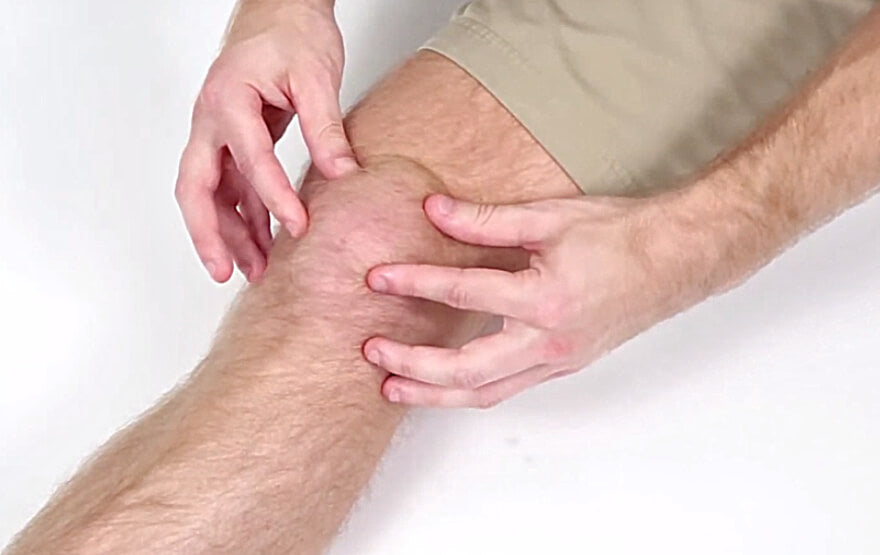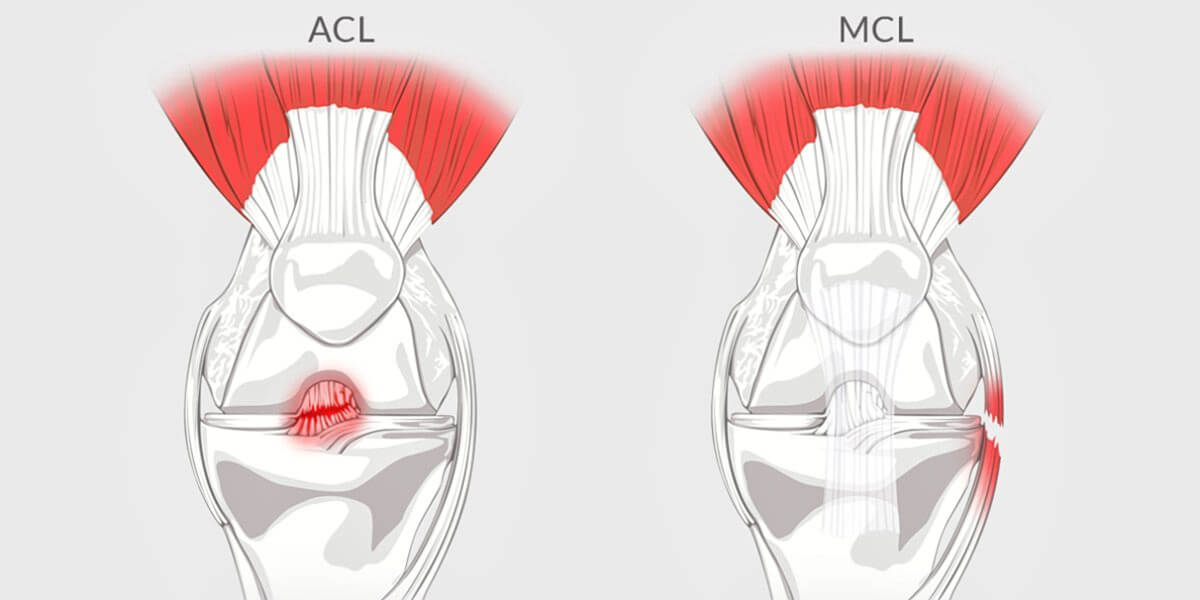Your Cart is Empty
Injury

The medial collateral ligament (MCL) provides stability to the knee joint and helps prevent excessive lateral movement that could compromise the structures of the knee. If you’ve recently suffered an impact or fall and are experiencing inner knee problems, you may have an MCL injury. MCL tears can be confusing to manage since it is usually accompanied by other tissue damage, but in this article we will guide you through the basics of an MCL tear and the differences between injury grades. We will also explain the symptoms and available treatments so you can start recovering.
An injury to the MCL can cause serious pain and inhibit our ability to walk, move, and participate in sports.
The medial collateral ligament is on the inner (or medial) side of the knee. It connects the tibia (shinbone) and femur (thighbone) to provide knee stability and prevent damaging joint movement.
An MCL tear can also be referred to as an MCL sprain, and the injury is graded based on severity. The grade system is used to identify and treat different levels of MCL sprains or tears.
A grade 1 MCL tear is the least serious. It indicates that the MCL has been stretched, but not seriously torn. More precisely, it occurs when under 10% of the fibers in the ligament have been torn. This grade is also called a mild MCL tear.
Also known as a partial MCL tear, a grade 2 MCL tear is more severe than a grade 1 injury. It is not a complete tear, but it is still serious. A grade 2 tear often leads to significant instability in the knee.
Unsurprisingly, a grade 3 MCL tear is the most severe. It involves the complete tearing of the ligament. The knee may feel like it is going to “give out” entirely with weight bearing activities.
 ACL and MCL are similar injuries, affecting different ligaments in the knee.
ACL and MCL are similar injuries, affecting different ligaments in the knee.
The symptoms of anterior cruciate ligament (ACL) and MCL tears are similar, but these are distinct injuries. Like the MCL, the ACL is one of four key ligaments that stabilize the knee. The ACL is found inside of the knee joint itself, preventing excessive forward movement of the knee, as opposed to the inner part, where the MCL is located.
Due to this positioning, an ACL tear is most commonly caused by sudden twisting, cutting, hyperextension of the knee, or direct impact to the front of the shin. Whereas, an MCL tear is generally caused by an impact to the outer part of the knee, which causes the inner knee joint to stretch.
When an ACL tear occurs, there is usually a loud popping sound. An MCL injury does not cause this noise. ACL tears are the most common type of knee ligament injury. With high impact injuries, it is also fairly common for an ACL and MCL tear to occur together along with other joint tissue damage.
Learn More About the Differences Between ACL & MCL Tears
An MCL injury occurs when the ligament is stretched or torn. The thick band of fibers is designed to prevent inward bending (a direction the knee is not supposed to go!) and to stabilize the knee. It is vulnerable to damage, particularly during sports.
Most people who tear their MCL do so during contact sports. A direct blow or impact to the outside of the knee can tear the ligament. This is particularly likely if the knee is slightly bent prior to contact.
The risk of tearing an MCL is still present even in non-contact sports due to repeated stops, starts and turns.
A sudden twisting of the knee can also cause the MCL to stretch or tear. Less commonly, the MCL can be injured in a fall, especially if your leg splays out beneath you at an odd angle. For this reason, older people can also be vulnerable to MCL injuries.
ACL and MCL injuries are in some ways similar; both can be caused by an intense impact, though generally to slightly different parts of the knee or leg.
The feeling of an MCL tear differs from person to person and based on severity. The main symptoms of an MCL tear include pain, instability, and swelling.
In the immediate aftermath of an impact to the knee, most people feel pain mixed with shock. However, the symptoms can worsen within a few hours. With a severe tear, it can quickly become very difficult, if not impossible, to put any weight on the leg.
For a mild or grade 1 tear, you may describe the feeling as tenderness or soreness. You may not notice any swelling in the area. For more severe tears, either at grade 2 or 3, the knee can be very unstable. In addition to swelling, you may see bruising.
Among the most common MCL tear symptoms and signs are:
In most cases, an MCL tear diagnosis is quick and straightforward, but occasionally additional tests may be necessary.
To diagnose whether you have an MCL tear (or to determine whether you have torn your MCL or ACL), your doctor may carry out a number of simple tests. Since an MCL tear is often also accompanied by an ACL tear or meniscus tear, your doctor should assess and rule out any other knee injuries or complications too.
Often it is possible to assess the injury from a straightforward examination of the knee. The doctor will carefully bend and apply pressure to the knee and assess your range of motion. He or she will also check for symptoms, such as swelling, tenderness to palpation, and muscle guarding (common in the hamstring).
In some cases, the doctor may order further tests to rule out other knee conditions or injuries. An X-ray may be used to check for a bone injury.
An MRI scan may also be considered. An MRI is particularly effective at detecting and diagnosing soft tissue injuries like MCL tears, meniscus tears, and ACL tears. MRI scans are totally painless and safe when needed. However, people with certain types of pacemakers cannot undergo this type of scan.
MCL injury recovery time varies from person to person based on a number of factors, such as age and fitness level, as well as the type of MCL injury sustained.
If you have suffered a grade 1 MCL tear, recovery time is usually under two weeks. In fact, some people return to sports or exercise in one week after a short period of rest, medication (like ibuprofen if needed), and appropriate exercise.
Grade 2 MCL tears take a little longer to heal. Four to six weeks is average, though this depends on your personal circumstances. Some people make a full recovery from a grade 2 injury in two to three weeks. Treatment will include initial rest, pain management, and exercise when ready.
The more serious grade 3 MCL sprains take longer to recover from. You may anticipate a recovery time of about eight weeks for these types of MCL tears. If you have also suffered ACL damage, recovery could take significantly longer (even 3 or more months). More extensive treatment from a specialist, like a physical therapist, will be needed to promote healing and restore appropriate balance and strength to the injured knee.
If you undergo MCL surgery, the recovery time is usually between two and three months. During this time, it is crucial to avoid relapse or further knee injuries. If you are an athlete, this unfortunately means you need to sit out for a while to protect yourself from long-term damage. The best way to get back to your sport as soon as possible is with the guidance of a physical therapist that specializes in sports medicine.
Remember not to push or overstretch your joint. Though the temptation to race through recovery is strong, overdoing it can cause additional problems and ultimately extend your recovery time.
Following these tips can help you to avoid further problems or injury.
First and foremost, heed the advice of your doctor or physiotherapist. They will assess the extent of your injury and provide treatment options and physical therapy that fit your specific needs. Avoid sports and vigorous activity until you are fully recovered to avoid worsening the MCL tear (the return should be gradual).
Regularly wearing a brace during sporting activities is also usually recommended with grade 2 and 3 sprains. This will help prevent additional injury. Wearing a good knee brace also keeps your awareness of the recent injury so you avoid making plays or actions that risk your knee health.
Be kind to your knees, especially if you’ve sustained an MCL tear. It may take some time, but if you treat the injury properly, follow the medical advice of your orthopaedic doctor or physiotherapist, and don’t overdo it, you will soon be back to the sports and activities you love.
Sources:
https://www.physio-pedia.com/Medial_Collateral_Ligament_Injury_of_the_Knee
https://www.webmd.com/pain-management/knee-pain/mcl-injury-what-to-know
SHOP MCL Products

![The Benefits of Flexibility [A.K.A. The Secret Sauce for Aging]](http://www.vivehealth.com/cdn/shop/articles/Smiling-retired-woman-listening-to-music-while-stretching-legs-outdoors._600x.jpg?v=1713090677)
